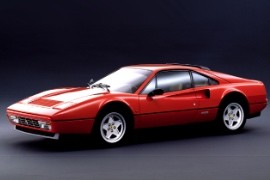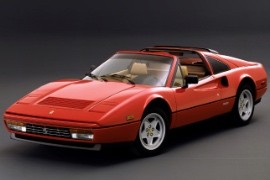FERRARI 328 GTB/GTS Models/Series Timeline, Specifications & Photos
First production year: 1985
Engines: Gasoline
Body style: Coupé (two-door)
Ferrari introduced the 328 range in 1985 as a successor to the 308 range in both shapes: coupe, known as GTB, and roadster, labeled as GTS and even though it shared some of its underpinnings with its predecessor, it was a much more modern car.
Customers started to ask for more power from their entry-level Ferraris in the '80s. Other automakers started to rev up their engines' technologies and provide more grunt. Ferrari, as a prestigious supercar maker, couldn't sit tight and do nothing. Moreover, the design language of the early '80s cars went through some changes, so the Italian brand also had to improve the aging 308 lineup. But instead of launching a facelifted version of that, it replaced the model entirely. As a result, in 1985, it came with the 328 GTB/GTS that were produced in a little over 7,400 units. It was a massive success for the ramping-horse brand.
At the front, the 328 GTB featured a low, flat nose with a slatted grille on it. That was flanked by pop-up headlights, which, when they were retracted, created an aerodynamic look for the vehicle. Unlike the 308, the 328 featured a body-colored front bumper, ditching the black rubber look of the one installed on the previous model. Underneath it, on the apron, Ferrari installed a second grille and a pair of fog lamps. From its profile, the raked windshield was supported by thin A-pillars and followed by a short roof. Behind it, the automaker installed side panels that created the image of a sloped back, even though the car featured a vertical rear windscreen. Behind the doors, the automaker placed another triangular glass area covered with a plastic grille in the first manufacturing years. Later, that idea was scrapped. Finally, at the back, the 328 GTB featured a flat deck for the engine cover and, on the rear fascia, it showed four round taillights on the upper side and a black diffuser under the body-colored bumper on the lower side.
The leather-wrapped interior boasted a high level of luxury in terms of materials' quality, but it wasn't that practical. There were just a few storage areas, one on the driver's door card and another one for the passenger's door card, an envelope-like compartment in the passenger's area, and a lockable center storage on the center console. The entire interior revealed an analog space but improved with modern features such as the buttons from the center console. Still, the gated gear stick with a dog-leg pattern to shift gears remained true to Ferrari's traditional style. Fronting the driver was an instrument cluster where the large rev counter and the speedometer were the most visible dials around. In addition, Ferrari added gauges for the coolant temperature and the fuel level.
Behind the cabin, Ferrari installed a 3.2-liter V8 engine with four valves per cylinder. It was an evolution over the powerplant installed in the 308, and, unlike that, it featured an Italian electronic ignition made by Marelli. Thanks to these improvements, the 328 GTB offered 273 PS (270 HP), which were sent to the rear wheels via a five-speed manual gearbox.
In 1985, Ferrari introduced a successor for the 308 range, the 328, which was available as a coupe and a roadster, named 328 GTB and 328 GTS, respectively. Even though it wasn't a completely new vehicle since it shared some of its underpinnings with the 308, it was heavily upgraded.
Ferrari received many questions from its customers if it couldn't make the 308 more powerful, so the engineering team started to work on a new powerplant. In addition, the company's management considered that a new bodywork based on the same structure as the 308 could complete the image. And then, the cabin could have been upgraded with more expensive materials and better design seats and controls. As a result, in 1985, the Italian automaker introduced the 328 GTS as an open-top version of the GTB. Surprisingly, the roadster version was produced in almost five times larger numbers than the coupe, even though it wasn't as stiff as its stablemate and it was more expensive.
At the front, the 328 GTS featured a low, flat nose with a slatted grille on it. That was flanked by pop-up headlights, which, when retracted, created an aerodynamic look for the vehicle. Unlike the 308, the 328 GTS featured a body-colored front bumper, ditching the black rubber look of the one installed on the previous model. Underneath it, Ferrari installed a second grille and a pair of fog lamps on the apron. From its profile, the raked windshield was supported by thin A-pillars, followed by a short removable panel for the roof. When it was opened, it created a targa styling since the rear panels behind the cabin remained in place to not spoil the car's look. Finally, at the back, the 328 GTS featured a flat deck for the engine cover and, on the rear fascia, it showed four round taillights on the upper side and a black diffuser under the body-colored bumper on the lower side.
The leather-wrapped interior boasted a high level of luxury in terms of materials' quality, but it wasn't that practical. There were just a few storage areas, one on the driver's door card and another one for the passenger's door card, an envelope-like compartment in the passenger's area, and a lockable center storage on the center console. The entire interior revealed an analog space but improved with modern features such as the buttons from the center console. Still, the gated gear stick with a dog-leg pattern to shift gears remained true to Ferrari's traditional style. Behind the seats, the automaker left a special area where the owner could store the roof while driving under the open sky.
Behind the cabin, Ferrari installed a 3.2-liter V8 engine with four valves per cylinder. It was an evolution over the powerplant installed in the 308, and, unlike that, it featured an Italian electronic ignition made by Marelli. Thanks to these improvements, the 328 GTS offered 273 PS (270 HP), sent to the rear wheels via a five-speed manual gearbox.

